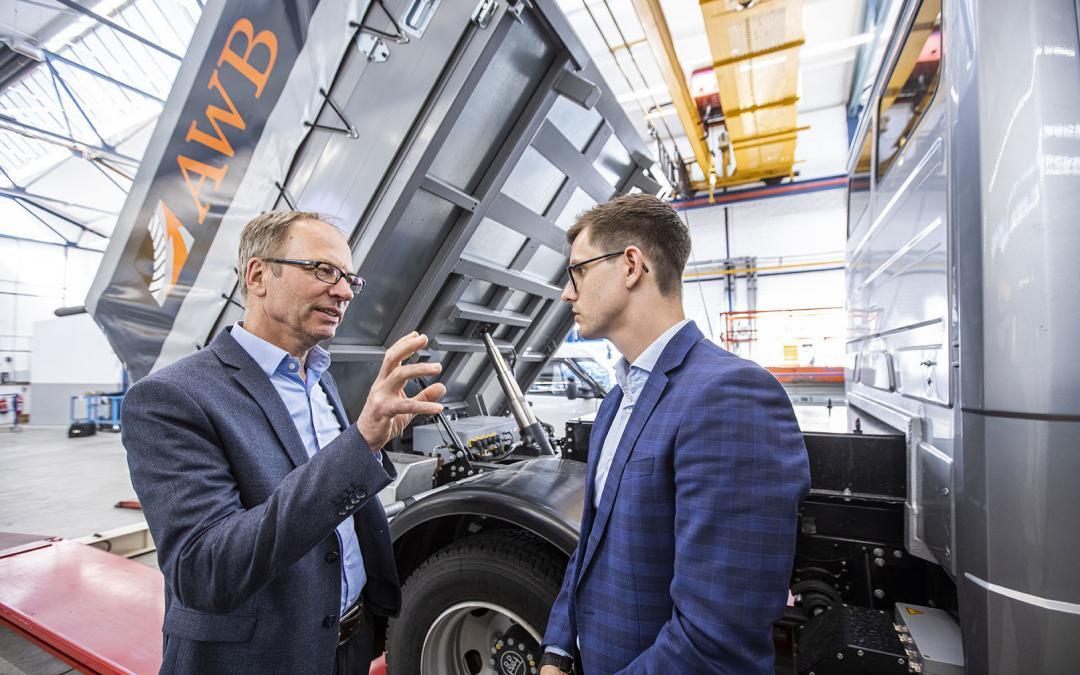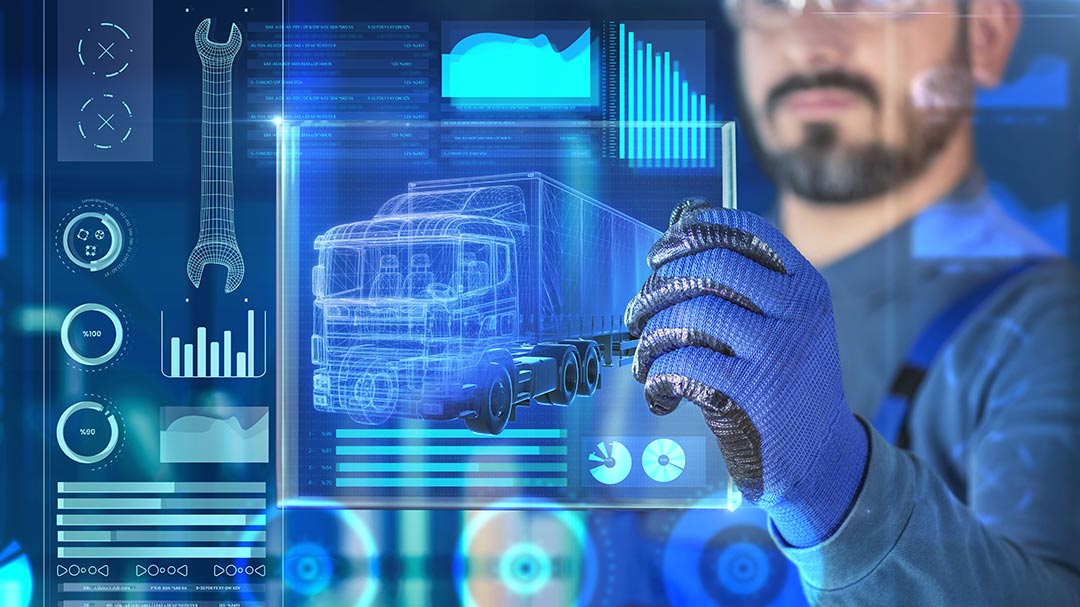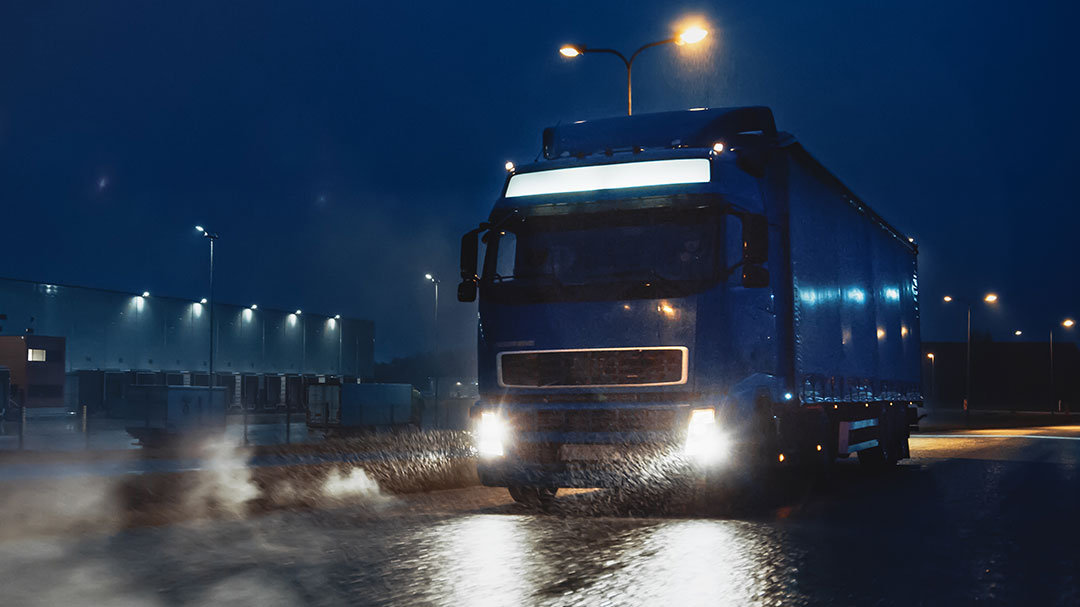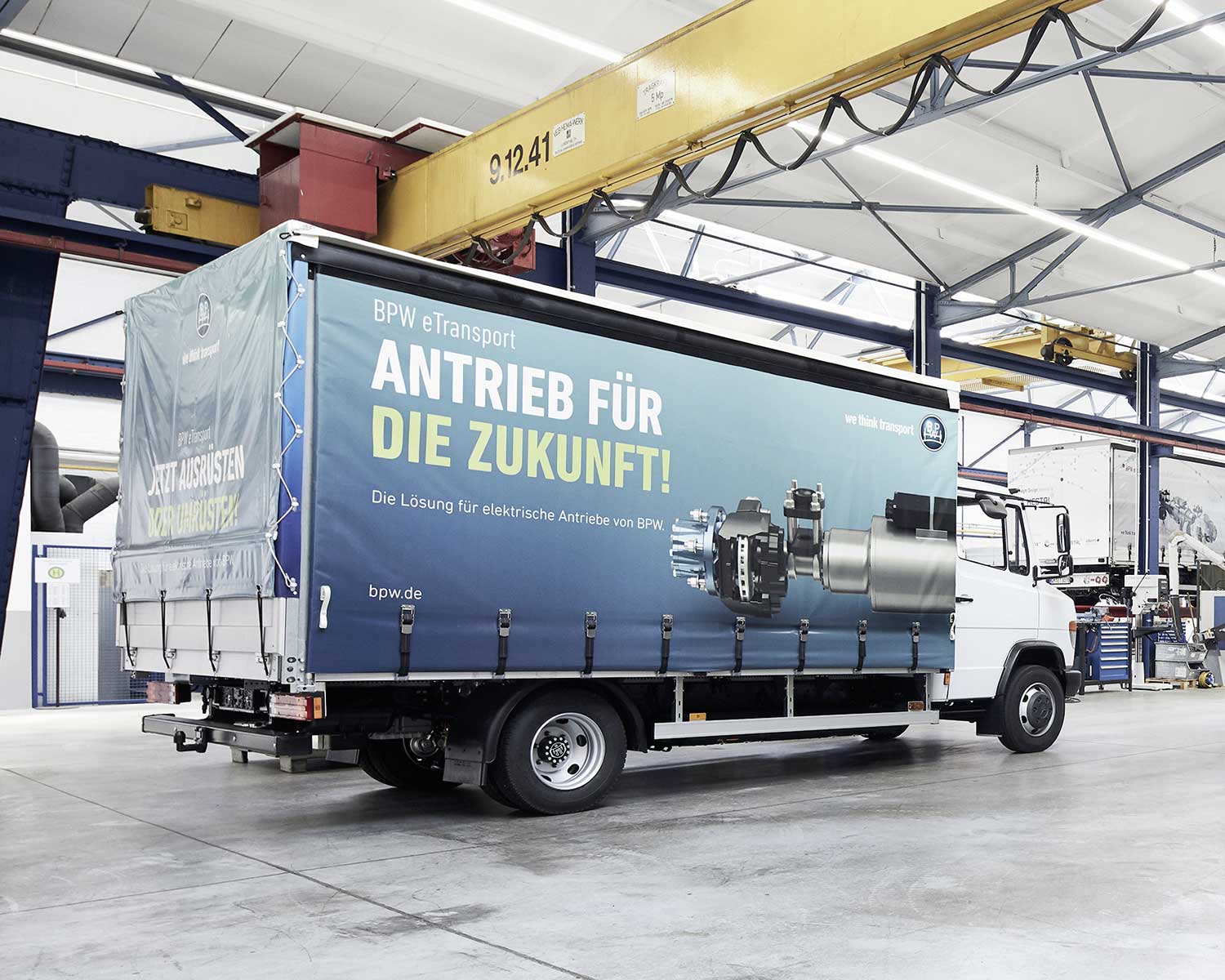Electromobility experts: Dr Bert Schröer (left) and Josha Kneiber discuss the challenges faced when converting the MB Vario with the eTransport from BPW.
Reading time approx. 5 minutes
Text: Joachim Geiger
Photos: Silvia Steinbach
The Mercedes-Benz Vario hasn’t been consigned to the history books yet, as Cologne’s municipal waste management company AWB will soon start using an electric version of the iconic truck for the first time. The 7.5-ton truck is set to put a new spin on urban mobility in the cathedral city. The commercial vehicle is driven by a spectacular piece of high-tech engineering: the eTransport drive axle from BPW.

Mechanical engineer Dr Bert Schröer is the head of the automotive engineering department for Cologne’s municipal waste management company AWB. The 57-year-old looks after a fleet of around 650 company vehicles.

Economist Josha Kneiber is part of the electromobility team at BPW. The 28-year-old is responsible for business development in this area.
Cologne’s municipal waste management company AWB is focusing on electromobility in the city. The latest addition in this field is a Mercedes-Benz Vario from the commercial vehicle company Paul Nutzfahrzeuge that has been modified with the eTransport electrically powered axle. Can’t Cologne afford a new vehicle?
Dr Bert Schröer: AWB is financed through the fees that residents pay for waste disposal and street cleaning. We therefore look very carefully at what we spend our money on. The electric MB Vario is an investment, of course, but it is an investment in the future. Aside from that, AWB is a typical recycling company and so it makes sense for us to recycle our own vehicles, too. We are putting the theory of waste management into practice.
Production of the MB Vario stopped six years ago. Why should a local authority add this relic to its fleet?
Schröer: Local authorities have to look far and wide to find a truck like the Vario these days. It has a high usable load and can be fitted with a snowplough or spreading equipment in winter. These are the key criteria for us. The market for vehicles with electric drives in the 4- to 7.5-ton segment is rather small, however, and, if you are also looking for a crew cab with a flatbed, there is nothing available at all. That’s why it was clear to us that we need to explore new avenues in shaping our urban mobility.
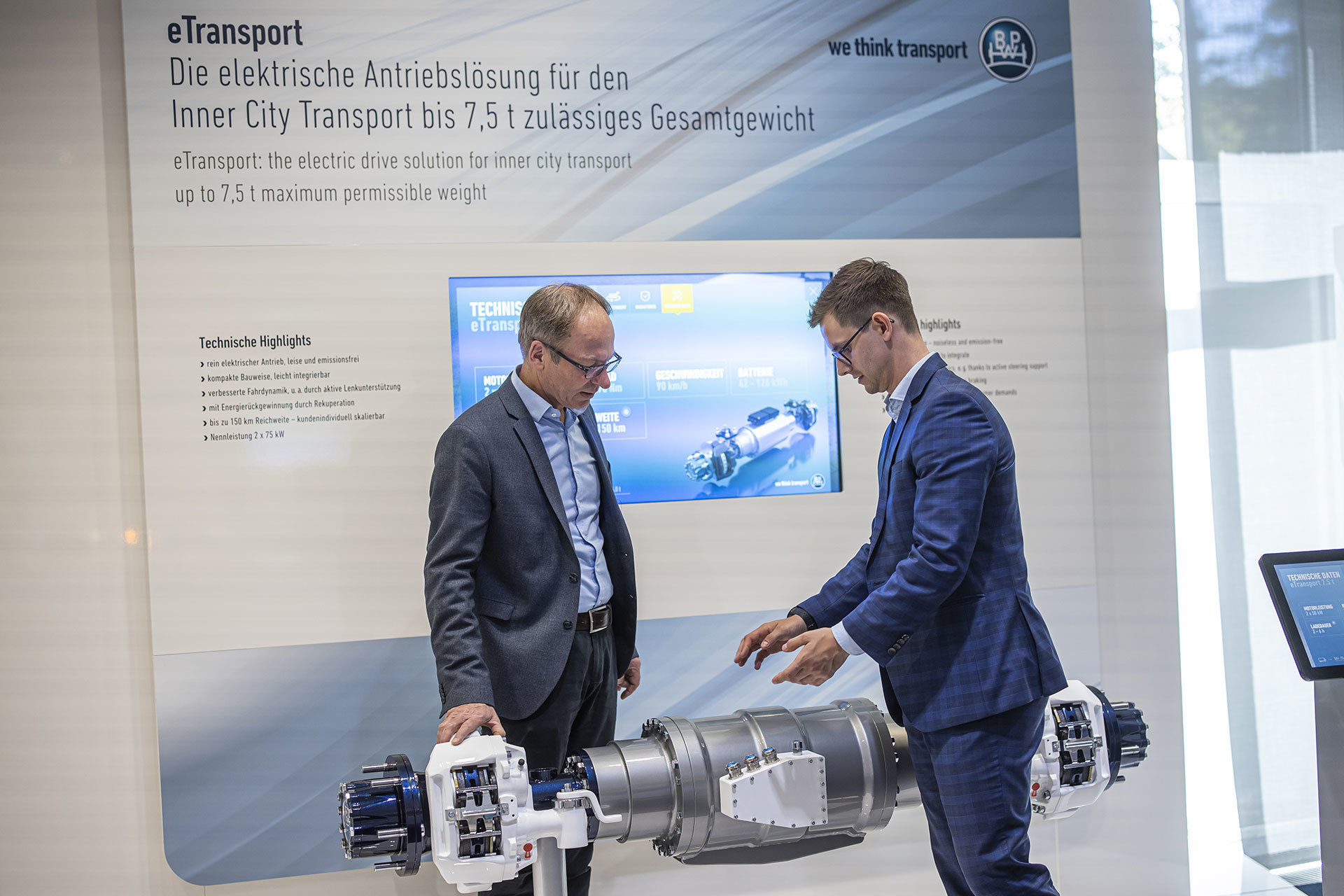
Model of the future: Josha Kneiber and Bert Schröer take a closer look at the new generation of the eTransport. This axle is being series-produced for the first time.
How did AWB and BPW come to collaborate on electromobility?
Schröer: It’s all down to chance – and a cup of coffee. Two years ago, I met a manager from BPW at a conference on clean-air planning held by the city of Cologne. During the break, he told me about the eTransport drive axle that BPW had just developed. This was the initial spark for a joint project. We didn’t waste time writing long concepts – we got started with implementation straight away. The first MB Vario that was due to be taken out of service was stripped of all its diesel components by our apprentices as part of a project and was delivered to Wiehl.
Josha Kneiber: It also takes pioneering spirit to put the conversion of trucks to electric drives into practice. AWB has been our partner from the outset. For example, it was a joint effort to work out how we could accommodate the rather-large batteries in the chassis. This was a real design challenge as we had a short wheel base of 3,150 mm to work with and needed to keep all six seats in the crew cab.
Out with the diesel – in with the electric drive. It can’t be that difficult, can it?
Kneiber: All in all, we spent almost a year and a half getting the vehicle to where it currently is. It isn’t just a matter of installing an electric drive axle. Battery management, servo steering, heating and various ancillary units also play a role in the overall system of the truck. Ultimately, all of the components in the vehicle need to be coordinated with each other. It’s just like in a big orchestra: it only takes one player to do something wrong for the whole piece to stop working. The latest model for AWB is now very close to series production. The software is being given the final fine-tuning at the moment to ensure that the components work together seamlessly.
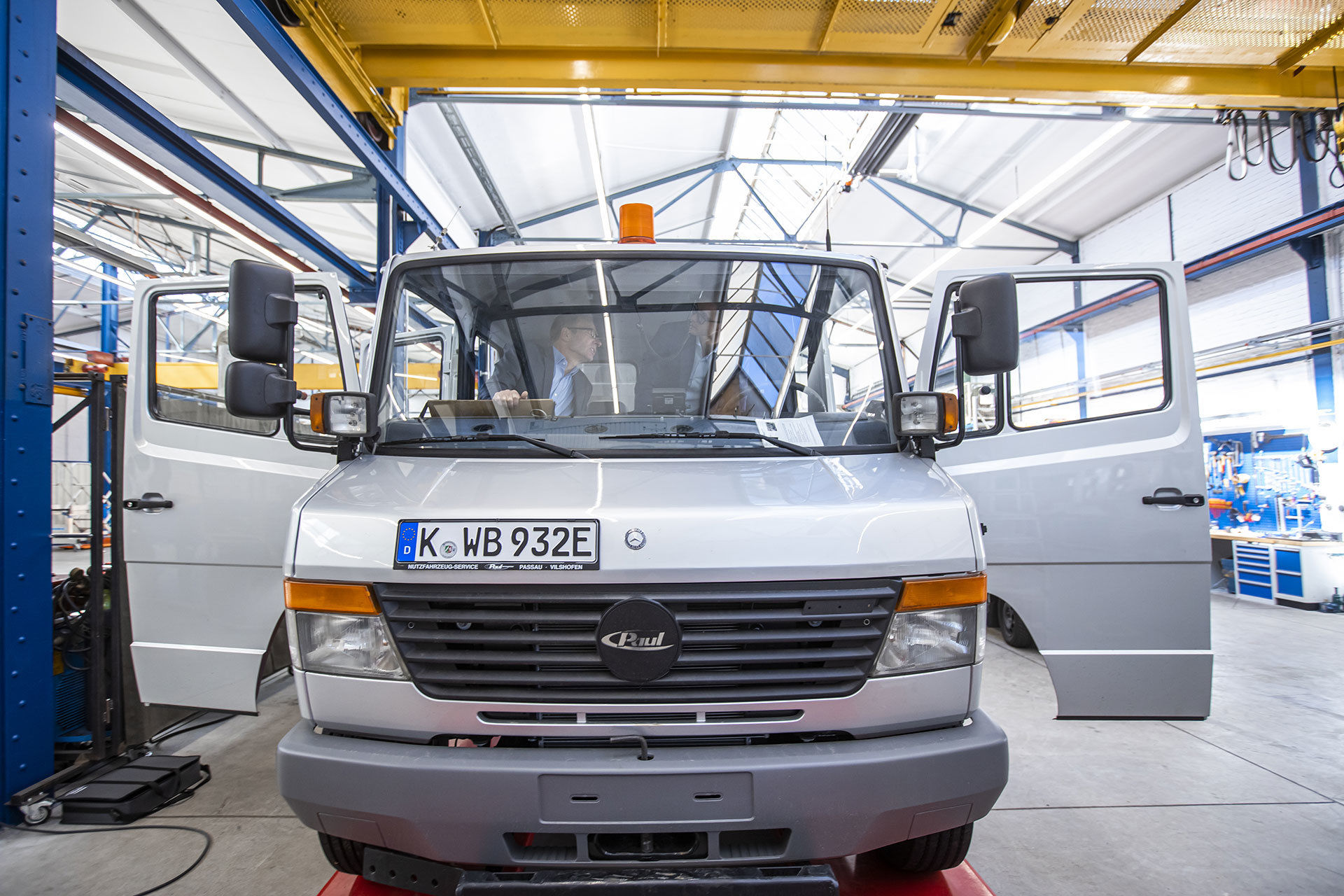
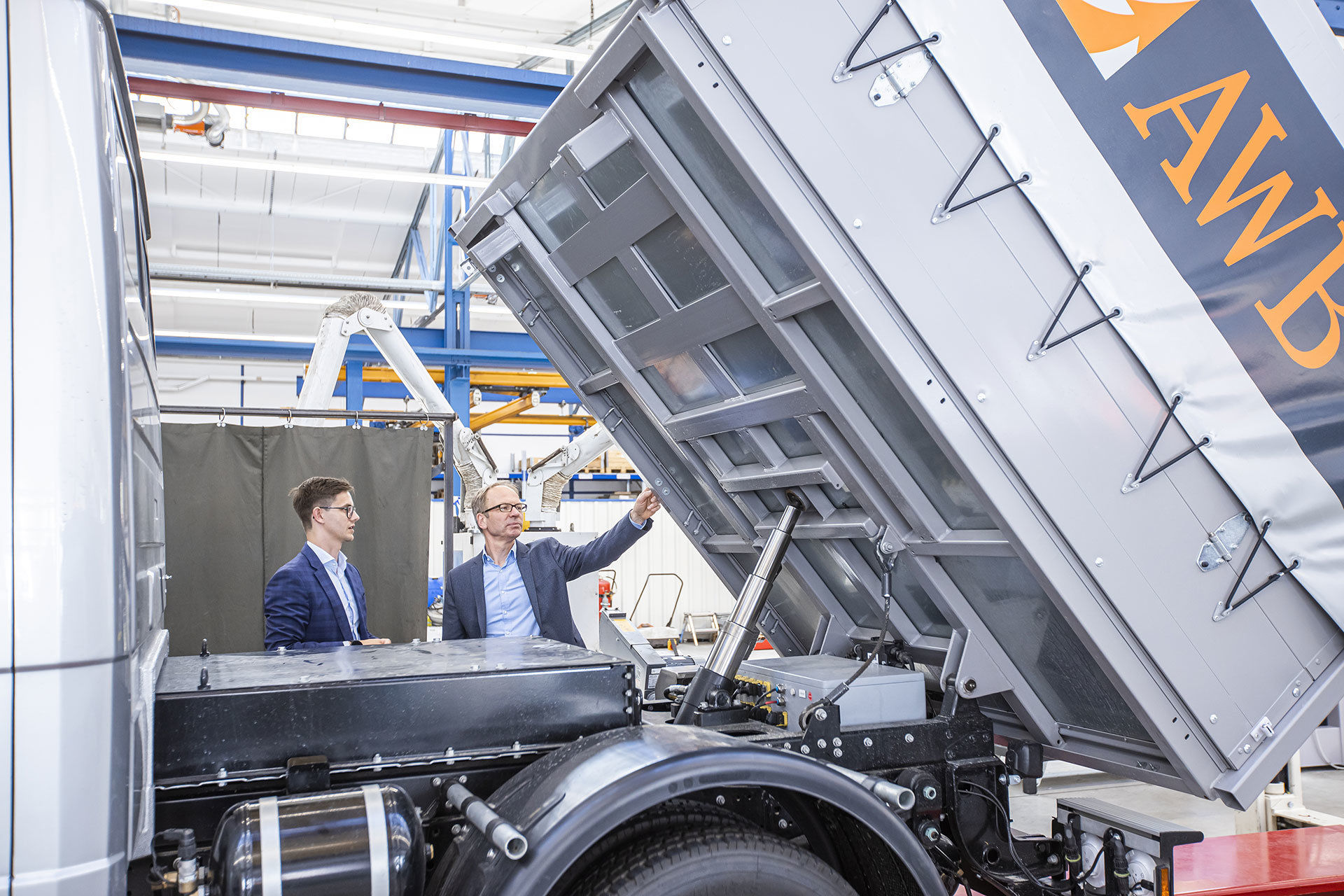
Smart solution: the battery packs sit above and below the ladder frame in the model with short wheel base. A cut-out section in the crew cab creates the necessary space.
How much Daimler technology is still in the Vario model with eTransport?
Kneiber: The shell of the Mercedes-Benz Vario is still the same. However, because we are replacing the entire drivetrain with the eTransport, we end up with a new commercial vehicle after the conversion, from a technical perspective. It will then be given a new vehicle identification number, too. This is possible because our partner Paul Nutzfahrzeuge has a manufacturer licence. The Vario is therefore no longer a Mercedes-Benz, but a Paul. If you wanted to give it a name, you could perhaps call it the Paul eVario.
Schröer: I see the electric Vario as a new vehicle after the retrofit. Since the electric truck has significantly fewer wear parts than a vehicle with a conventional engine, it can also set new standards when it comes to maintenance and repair. We are expecting cost savings of around 30 per cent. The Paul vehicle has made an excellent impression so far in the test drives. It’s no longer the good old MB Vario – the electric model is better.
What jobs will the Paul with eTransport be doing for AWB in Cologne?
Schröer: It will be entering service in the coming weeks and will then be used as a team vehicle for street cleaning – this was previously the domain of the MB Vario. The vehicle will be staffed by a team of four street cleaners plus the driver. That’s why the crew cab is so important for us, as it can accommodate an entire team. When they reach their zone, the cleaners fan out and fill bags with rubbish or shovel it onto the loading area of the rear dumper truck. By the end of the shift, the team vehicle will have clocked up 40 to 50 kilometres.
I don’t imagine the drivers are pleased when the promised new vehicle actually turns out to have been resurrected from the scrap heap?
Schröer: We have lots of different vehicles in the fleet. The MB Vario is by far the most popular with the drivers, which is surprising because it is quite loud inside. But it has cult status like the Citroën 2CV used to have. The electric model also has the potential to become the favourite among the street cleaners. The driver who will be taking on the electric Vario for his patch in west Cologne is already looking forward to having the new machine. And the pair might make a big impact as an advert for AWB at the Cologne carnival.
»AWB BELIEVES THAT IT MUST PLAY ITS PART IN KEEPING THE AIR CLEAN IN COLOGNE WITH ITS VEHICLES.«
Dr.-Ing. Bert Schröer,head of the automotive engineering department, AWB Cologne
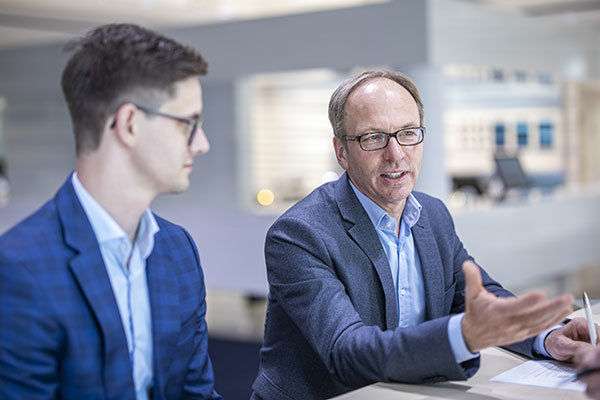
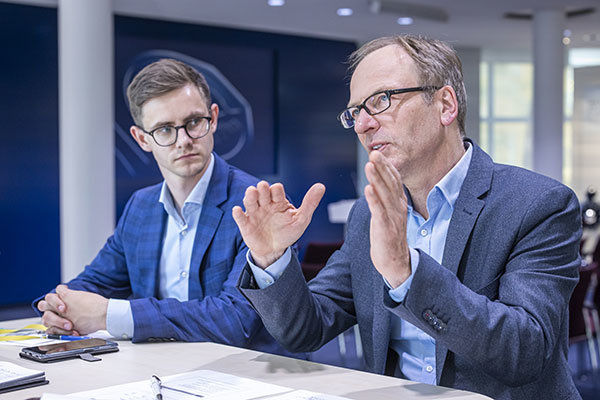

»OUR AIM IS TO GIVE INNOVATIVE CUSTOMERS SUCH AS AWB IN COLOGNE EXTENSIVE SUPPORT.«
Josha Kneiber, business development for electromobility at BPW
Bring on the parade! But isn’t the electric truck too small to be a float?
Schröer: Our supporting role doesn’t start until after the parade of floats: we follow the revellers with an armada of road-sweeping vehicles, team vehicles and street cleaners, who work at top speed to remove the piles of rubbish from the streets. The teams have to work together perfectly on the day – every move has to be just right. Many carnival visitors stay around after the parade to watch this spectacle. That’s why we’ve devised some carnival covers for our vehicles with a fun design and amusing slogans that will be hung over the existing tarpaulins like a curtain. The tarpaulins for our electric truck are already being planned and we are thinking up a special theme.
Speaking of special, the 7.5-ton model that BPW is currently producing for AWB is being built by hand. What will be different in series production?
Kneiber: When the small-series production starts, the vehicles will feature an industrially produced axle that will further optimise the performance and range. Our engineers have revisited the concept for the motors, too. Instead of a high-speed asynchronous machine, the housing will have a permanent-magnet synchronous machine in future, which offers advantages such as a reduction in background noise. We have also achieved greater continuous output with a new cooling system. This will pay off in winter when the truck is out and about with a snowplough.
What will the timetable be for future production of the electrified Vario?
Kneiber: The small-series production is set to start in the coming months. Then we will also be taking orders from customers. We believe we can produce 30 units this year. If we convert 250 to 300 vehicles on the Mercedes-Benz platform by 2023, we will have done a good job.

